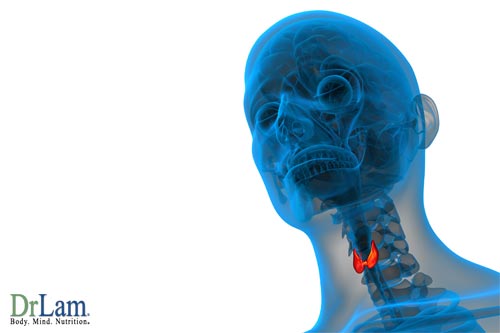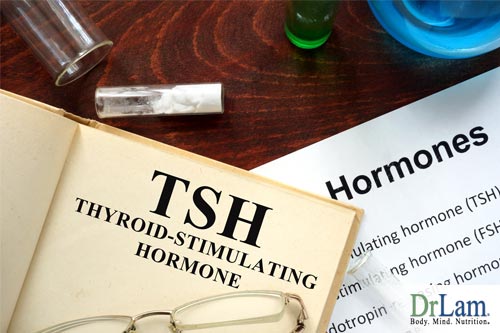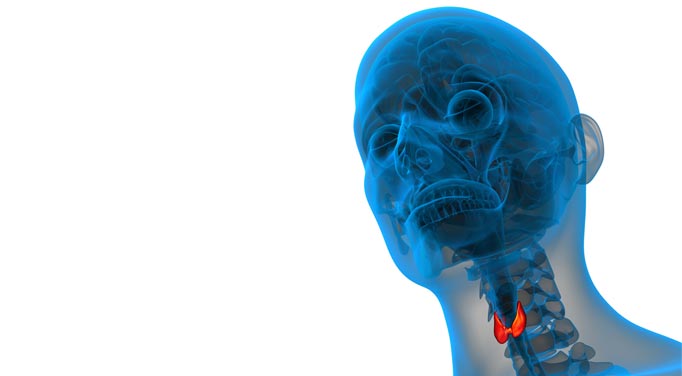The following table outlines the key differences in the signs and symptoms between Adrenal Fatigue and hypothyroidism symptoms.
| Characteristics | Adrenal Fatigue | Hypothyroidism |
| Body Measurements | ||
| Weight | Early: gain weight; severe - cannot gain weight | Generalized weight gain |
| Body Temp | 97.8 or lower | Low 90s to 98.6 |
| Temp regulation | fluctuating and exaggerated | Steady |
| Mental Function | ||
| Mental Function | Brain Fog | Slow thinking |
| Depression | Sometimes | Frequent |
| Physical Looks | ||
| Eyebrows | Full | sparse outer 1/3 |
| Hair | Thin, sparse on extremities | Coarse and sparse |
| Hair loss | Sometimes | Common |
| Nails | Thin, brittle | Normal to thick |
| Peri-orbital Tissue | Sunken | Puffy |
| Skin | Thin | Normal |
| Skin tone | Dry | Oily or moist |
| Internal feeling | ||
| Ligaments Flexibility | Good | Poor |
| Fluid retention | No | Yes |
| Pain | Headache, muscular, migraines | Joints, muscles |
| Reactivity | Heightened and hyper-reactive | Hypo-reactive |
| Medical condition | ||
| History of Infections | Common | Occasional |
| Chronic Fatigue | Yes | Yes |
| Orthostatic Hypotension | Frequent | No |
| Blood Sugar Levels | Tendency toward hypoglycemia | Normal to hyperglycemia |
| Heart Palpitation | Frequent | No |
| GI function | Irritable or hyperactive | Constipation and hypoactive |
| Mal absorption | Yes | No |
| Sensitive to Medications | Frequent | Normal |
| Personality Traits | ||
| Personality Type | Type A | Type A or B |
| Obsessive Compulsive | Frequent | Mixed |
| Habits | ||
| Sleep Pattern | Wake up 2-4 am | Sleepy |
| Temperature Tolerance | Intolerance to Cold | Intolerance to Heat |
| Food Craving | Craving for sweet and salty | Craving for Fats |
 Iodine is an important mineral for the health of the body thyroid glands. It is needed for the production of T3 and T4, thyroid hormones critical in regulating the body’s metabolism. Without sufficient iodine, insufficient production of these hormones affects the body’s function and metabolism, leading to the development of hypothyroid symptoms. Fixing these kinds of hypothyroid symptoms is relatively simple, only needing an adequate amount of iodine for the thyroid to use in the production of thyroid hormones. Iodized salt and vegetables are common dietary sources, while iodine supplementation is a more reliable and exact method of acquiring dietary iodine.
Iodine is an important mineral for the health of the body thyroid glands. It is needed for the production of T3 and T4, thyroid hormones critical in regulating the body’s metabolism. Without sufficient iodine, insufficient production of these hormones affects the body’s function and metabolism, leading to the development of hypothyroid symptoms. Fixing these kinds of hypothyroid symptoms is relatively simple, only needing an adequate amount of iodine for the thyroid to use in the production of thyroid hormones. Iodized salt and vegetables are common dietary sources, while iodine supplementation is a more reliable and exact method of acquiring dietary iodine.
Conventional physicians also tend to prescribe prescription hormone medications designed to replace thyroid hormones. However, 70% of people taking thyroid replacement medications continue to complain of symptoms. It is not unusual to have concurrent presenting symptoms of both low adrenal and low thyroid functions. Conventional medicine tends to miss this due to ignorance on Adrenal Fatigue. Those who were diagnosed as hypothyroid after a traumatic and stressful event such as pregnancy, accident, infection or an emotional trauma such as divorce or death of a loved one should especially be on the alert if thyroid replacement alone is not helping.
Those who have poor body temperature regulation are more prone to have mixed presentation. This group of people may present a steady low body temperature from low 90's to a little below 98.6F. They may also present a slight exaggerated response in body temperature as compared to the environmental temperature as characterized by a sensation of feeling hot when it is warm and cold when it is cool outside.
Hypothyroidism can be primary or secondary. Primary hypothyroidism can easily be cured with administration of thyroid replacement therapy. If hypothyroid symptoms such as dry skin, low body temperature, fatigue, and weight gain persist despite thyroid replacement therapy regardless of laboratory values, one must look elsewhere for the cause of the low thyroid function.
Secondary hypothyroidism is low thyroid function caused by malfunction of another organ system. One of the most frequently overlooked causes is Adrenal Fatigue. Adrenal Fatigue is perhaps the most common cause of secondary low thyroid function, both clinically and sub-clinically. Low adrenal function often leads to low thyroid function, classically evidenced by high levels of thyroid binding globulin (TBG), low free T4, low free T3, high TSH, slow ankle reflex and low body temperature. Few physicians are trained to detect this connection. Fortunately, secondary hypothyroidism can be reversed when the underlying root problem (such as Adrenal Fatigue) is resolved.
When the adrenals are exhausted, the ability of the adrenals to handle the stress associated with normal bodily functions and energy requirements is often compromised. To enhance survival, the adrenals force a down-regulation of energy production. In other words, the body is being metabolic down-regulated to slow down in order to conserve energy as the body needs to rest. Lower energy output reduces the workload of the body. In times of stress, this is exactly what the body wants. As the thyroid down-regulates, production of thyroid hormones T4 and T3 is reduced. The down-regulation also leads to an increase in thyroid binding globulin (TBG) level. As a result of increased TBG, more thyroid hormones are bounded on a relative basis and less is released to the body cells where they work.  This leads to reduced free T4 and free T3 levels in the blood if measured (while total T3 and T4 levels may be normal). In this well orchestrated systemic down-regulation to enhance survival, the body also shunts some of the available T4 towards the production of the inactive reverse T3 (rT3) which acts as a braking system and opposes the function of T3. This reduction in T3 combined with an increase in rT3 may persist even after the stress has passed and cortisol levels have returned to normal. Furthermore, rT3 itself may also inhibit the conversion of T4 to T3 and may perpetuate the production of the inactive rT3. If the proportion of rT3 dominates, then it will antagonize T3 and possibly leading to a state called rT3 dominance. This results in hypothyroid symptoms despite sufficient circulating levels of T4 and T3. The body therefore has multiple pathways to down-regulate energy production to enhance survival under the direction of the adrenal glands.
This leads to reduced free T4 and free T3 levels in the blood if measured (while total T3 and T4 levels may be normal). In this well orchestrated systemic down-regulation to enhance survival, the body also shunts some of the available T4 towards the production of the inactive reverse T3 (rT3) which acts as a braking system and opposes the function of T3. This reduction in T3 combined with an increase in rT3 may persist even after the stress has passed and cortisol levels have returned to normal. Furthermore, rT3 itself may also inhibit the conversion of T4 to T3 and may perpetuate the production of the inactive rT3. If the proportion of rT3 dominates, then it will antagonize T3 and possibly leading to a state called rT3 dominance. This results in hypothyroid symptoms despite sufficient circulating levels of T4 and T3. The body therefore has multiple pathways to down-regulate energy production to enhance survival under the direction of the adrenal glands.
Read Part 2 Now!
© Copyright 2013 Michael Lam, M.D. All Rights Reserved.
It may be one of the symptoms of hypothyroidism. Generally, the whole body is dry and not specifically limit to the feet.
If you have AFS, you may suffer from subclinical thyroid issue also. As a result, your need for thyroid medication could go up from time to time, and you still have the same unresolved symptoms. This is a sign that you should look into your adrenal health.
When the thyroid is hard to manage, someone is going on. AFS is one of those possibilities.

